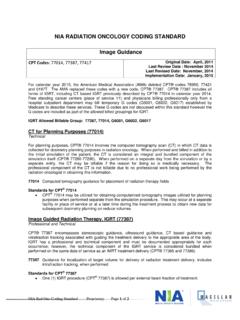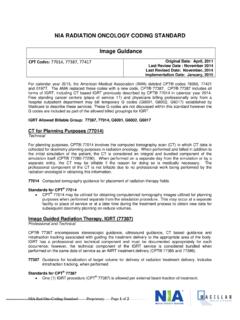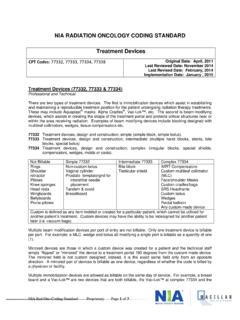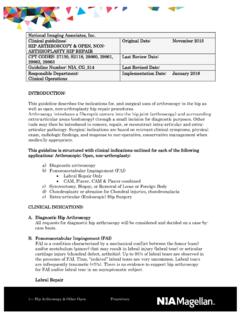Transcription of NIA RADIATION ONCOLOGY CODING STANDARD …
1 NIA Rad Onc- CODING STANDARD Proprietary Page 1 of 7 NIA RADIATION ONCOLOGY CODING STANDARD dosimetry planning CPT Codes: 77295, 77300, 77301, 77306, 77307, 77321, 77316, 77317, 77318, 77331, 77399 Original Date: April, 2011 Last Reviewed Date: November, 2014 Last Revised Date: November, 2014 Implementation Date: January, 2015 dosimetry planning is the process of determining the amount, rate, and distribution of RADIATION emitted from a source of ionizing RADIATION , based on the physician s prescription for a specific patient. Different methods of dosimetry planning may be utilized based on the type of treatment delivery prescribed by the physician; however, only one dosimetry planning service is typically necessary per phase of treatment delivery.
2 In addition to STANDARD isodose planning and more advanced conformal three-dimensional or intensity modulated planning , dosimetry services may also include monitor unit calculations and special dosimetry services to further translate and assure the appropriate RADIATION dose to the target area. dosimetry services are performed by a medical dosimetrist and/or a qualified medical physicist under the direction of a RADIATION oncologist. This CODING STANDARD demonstrates the appropriate utilization of these codes. Isodose Plans (77306, 77307) Professional and Technical For calendar year 2015, the American Medical Association (AMA) deleted CPT codes 77305, 77310 and 77315. The AMA replaced these codes with new codes, CPT 77306 and 77307. An isodose plan is a graphic display of patient s anatomy to include the distribution of RADIATION based on a prescribed dose and plan of care created by a RADIATION oncologist.
3 These codes are not billable on the same date of service with 3-dimensional radiotherapy plan (CPT 77295) or an intensity modulated radiotherapy plan (CPT 77301) as these dosimetry planning techniques represent a more advanced and conformal method of distributing RADIATION doses to targeted treatment areas. 77306 Teletherapy isodose plan; simple (1 or 2 unmodified ports directed to a single area of interest), includes basic dosimetry calculation(s) 77307 Teletherapy isodose plan; complex (multiple treatment areas, tangential ports, the use of wedges, blocking, rotational beam, or special beam considerations), includes basic dosimetry calculation(s) standards for CPT 77306 and 77307 Electron only plans are billable as CPT 77321 and not CPT 77306 or 77307. These codes are not both billable for the same isodose plan.
4 Only one isodose plan is allowed per volume of interest. Contiguous volumes of interest such as breast tangents and supraclavicular nodal fields are considered one volume of interest, therefore, additional isodose plans are not allowed. In addition, with current planning techniques, a single isocenter planning process is routine which further supports a single plan for these contiguous volumes. NIA Rad Onc CODING STANDARD Proprietary Page 2 of 7 One (1) isodose plan may be approved for all 2D external beam plans and 3D external beam boost plans in which a 3D isodose plan (CPT 77295) has already been billed during the same course of therapy. Three-dimensional Radiotherapy Plan (77295) Professional and Technical 77295 3-deminsional radiotherapy plan, including dose-volume histogram.
5 Three-dimensional planning involves computer reconstruction of a delineated tumor volume and surrounding critical normal tissue structures from a CT scan and/or MRI data in preparation for non-coplanar or coplanar therapy. This planning utilizes documented three-dimensional beam s eye view volume dose displays of multiple or moving beams. This procedure combines a computer-aided field setting simulation with isodose planning which occurs during dosimetry treatment planning . 3D radiotherapy plans are billable as one per treatment course; however, there are occasional scenarios in which more than one 3D radiotherapy plan may be medically necessary. A new CT data set supporting a significant change in the tumor volume and documented medical necessity are required to claim another 3D conformal plan.
6 When performing a 3D radiotherapy plan, a separate charge for an isodose plan would not be appropriate for the same segment of treatment of that volume. This is due to the isodose plans being utilized as a component of the 3D radiotherapy plan. It would be appropriate, however, to bill an isodose plan for a boost or cone-down performed on the same CT data set, which was used for the initial conformal plan. standards for CPT 77295 One (1) 3D radiotherapy plan (CPT 77295) may be approved for each course of 3D external beam treatment delivery. Only one 3D radiotherapy plan is allowed per course of therapy, unless there is documentation of medical necessity and a second CT data is performed which demonstrates a significant change in patient anatomy and/or delineated tumor volumes.
7 In this instance an additional 3D radiotherapy plan may be appropriate The work performed within a 3D radiotherapy plan includes isodose planning ; therefore, it would not be appropriate to bill for an isodose plan (CPT 77306-77307) or a teletherapy port plan (CPT 77321) in addition to CPT 77295 for the same segment of therapy. One (1) 3D radiotherapy plan (CPT 77295) may be approved for each course of Stereotactic Radiosurgery (SRS) or Stereotactic Body RADIATION Therapy (SBRT). (See Reference 1.) 3D radiotherapy plans may be appropriate for HDR and LDR brachytherapy treatment courses. CPT 77295 may be utilized in lieu of brachytherapy isodose plans (CPT 77316 77318); if 3D criteria are met, however, only 1 is allowed per course of therapy.
8 3D radiotherapy plans may be appropriate for proton or neutron treatment courses. CPT 77295 may be utilized in lieu of teletherapy isodose plans (CPT 77321); however, only 1 is allowed per course of therapy. CPT 77295, 3-Dimensional Radiotherapy Plan, is not billable for IMRT boost plans. IMRT Plan (77301) Professional and Technical 77301 Intensity modulated radiotherapy plan, including dose-volume histograms for target and critical structure partial tolerance specifications. NIA Rad Onc CODING STANDARD Proprietary Page 3 of 7 Intensity-Modulated RADIATION Therapy (IMRT) is a computer-based method of planning delivery of treatment for tumors within a patient. IMRT allows for delivery of highly conformal dose distributions to complex targets positioned near sensitive normal tissues.
9 Conforming the dose to the target area, and away from sensitive normal tissues, improves therapeutic ratios. IMRT utilizes many non-uniform RADIATION beam intensities within varied amounts of beam angles to deliver the conformal dose. These non-uniform beam intensities are determined by a computer-based optimization technique known as inverse planning . Inverse planning requires the planner to identify treatment volumes for planning as well as distinguish the sensitive normal structures near or adjacent to the treatment volume. The physician is required to supply dose constraints for the normal structures and dose goals for the target area. These goals and constraints allow the IMRT planning software to reverse engineer the plan.
10 IMRT treatment delivery is not confined to the use of a Multi-Leaf Collimator (MLC) as long as the delivery results in highly modulated intensity resultant from the planning process described above. IMRT static compensators may also be used. The use of an MLC just to produce simple one-dimensional ramp intensity distributions is excluded because the inverse planning process is not necessary to produce this simple intensity variation. An IMRT plan (CPT 77301) is billable only one time during a course of therapy. In rare cases, billing a second IMRT plan during the same course of therapy may be warranted. In this scenario, planning from a new CT data set showing a substantial change in the delineated tumor volume/volume of interest or patient anatomy is required.








![Sleep Solution for [Health Plan] Members - RADMD-HOME](/cache/preview/f/e/0/e/6/2/1/8/thumb-fe0e6218ba49aea2ca3bc8bae4bee357.jpg)
